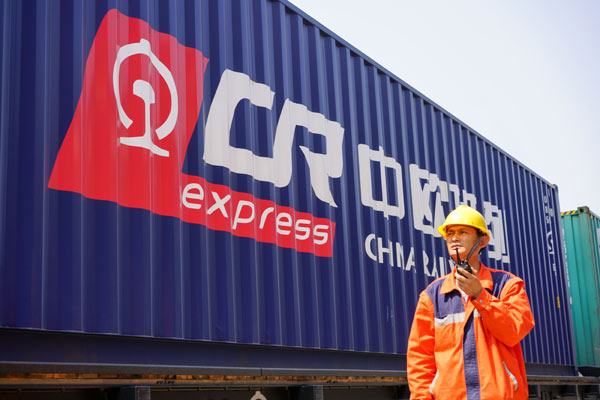Pivot in go-west campaign
 |
|
A worker oversees loading of containers onto a Chongqing-Xinjiang-Europe intercontinental freight train in Chongqing, which will speed up the setting up of a comprehensive international logistics system. [Photo/Xinhua] |
Editor's Note:
In this third part of the special series on the new free trade zones being set up across China, we look at the three projects coming up in Chongqing, Sichuan and Xi'an. The FTZs enjoy preferential policies, more favorable taxes, easier customs clearance, and simpler business procedures. Each FTZ has a focus on certain industry segments, into which it will deploy capital and top talent. The special package below informs you how the three new FTZs will transform the economic, cultural and social fabric of the areas they serve.As the latest addition to China's Free Trade Zones project, Chongqing plans to become a pivot in the country's go-west campaign-the national effort to develop the vast western regions, home to energy and mineral resources crucial to its future growth.
The central government announced the launch of the China (Chongqing) Pilot Free Trade Zone on April 1. The third batch of FTZs includes Chongqing municipality, Henan, Hubei, Liaoning, Shaanxi, Sichuan and Zhejiang provinces.
The total number of FTZs has reached 11 after the first FTZ (Shanghai) opened for business in 2013.
Chongqing FTZ, spanning about 120 square kilometers, comprises three parts-Liangjiang New Area, Xiyong area and Guoyuan Port area.
According to the FTZ blueprint, Chongqing will build itself into a pilot zone of inland free trade featuring a convenient investment and trade environment, efficient supervision, complete finance services as well as a sound legal environment for business.
In addition to practices and policies common to all the FTZs, "Chongqing will speed up the construction of a comprehensive international logistics system based on the current Chongqing-Xinjiang-Europe intercontinental railway," said Vice-Mayor Liu Guiping at the press conference of the launch of the Chongqing FTZ.
"We are going to explore strategies and policies to support the Belt and Road Initiative and find out how to make land trade rules."
In three years, Chongqing FTZ will become the center of international logistics, inland services trade and inland finance, Liu said.
As the only municipality in western China, the traditional industrial hub, located at the intersection of the Belt and Road Initiative's trade route and the Yangtze River Economic Zone, has witnessed fast and steady economic growth in recent years and led the country's GDP growth rate table for two consecutive years in 2014 and 2015.
 |
|
A barista shows how to taste coffee at the coffee trade center in Chongqing. [Photo/Xinhua] |
Thanks to its comprehensive transportation system spanning air, water and land, the city of 30 million people is also one of the nine key logistics centers in the country.
Chongqing Jiangbei International Airport is one of the eight major airline hubs in China. An ongoing expansion project will increase its annual throughput of passengers to 45 million.
Guoyuan Port, which is linked with the Chongqing-Xinjiang-Europe International Railway, has 16 berths and can handle 6 million metric tons of bulk cargo annually. Coal and iron ores from the Xinjiang Uygur autonomous region and Gansu province are transferred at the port.
Goods from neighboring provinces and countries are transported to Shapingba Tuanjiecun railway terminal and sent to Central Asia and Europe.
Last year, the city was picked as the operational center of the China-Singapore (Chongqing) Demonstration Initiative on Strategic Connectivity, the third intergovernmental project between the two countries. The initiative will pilot cooperation in fields ranging from financial services, aviation, transportation and logistics to information communications technology.
Liangjing New Area will play a key role in Chongqing FTZ as it covers most of the FTZ area and functions. The operational center for Sino-Singapore (Chongqing) project is also located in the new area.
Established in 2010, Liangjiang is the third national development and opening zone in China-and the first in the inland-approved by the State Council, after Shanghai Pudong New Area and Tianjin Binhai New Area.
"We should combine the Sino-Singapore program with the FTZ project so that we can achieve the real free flow in trade, human resources and commodities," said Tang Zongwei, deputy director of the Liangjiang New Area Administrative Committee.
Many foreign companies have already entered Chongqing to expand their presence in China's inland.
Cui Wei, regional director of West China at Prologis, the world's second-largest logistic company, has recently signed an agreement with Chongqing Logistics Park located in the FTZ to build a logistics center for the Chongqing-Xinjiang-Europe intercontinental railway.
"The FTZ will be more open in many areas, such as capital and talent flow, and our company will surely benefit from that," he said.
- Chongqing wakes up and smells the coffee
- Chongqing puts 30m yuan towards forests
- Engineering construction contract dispute between Chongqing Yipin Construction Group Co, Ltd and Sichuan-based Jiayu Real Estate Development Co, Ltd
- Creditor interest dispute between Huang Shulan, Zheng Daohong, Zheng Jing and Chongqing-base Yingdan Property Management Group Co, Ltd
- A glimpse of coffee exchange in Chongqing























